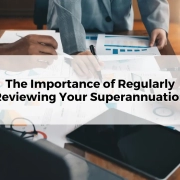The Role of Financial Planning in Transitioning to Retirement
Table of Contents
ToggleTransitioning into retirement is not a single event—it’s a meticulously staged financial evolution. This period, often regarded as a major life milestone, demands strategic foresight and refined planning. With Australia’s ageing population and increasing life expectancy, ensuring financial longevity is no longer a luxury—it’s an imperative.
Effective retirement planning must incorporate cash flow structuring, asset allocation, tax strategies, superannuation optimisation, and lifestyle objectives. Without a robust framework in place, retirees risk running out of capital, compromising quality of life and independence in later years.
As a Toowoomba Financial Adviser, I work with clients to turn uncertainty into clarity by creating tailored financial roadmaps. By engaging early with comprehensive financial planning, Australians can retire with confidence, knowing their affairs are in order and their lifestyle ambitions are attainable.
Defining the Retirement Transition Phase
The retirement transition phase typically occurs during the five to ten years before an individual ceases full-time work. This timeframe is pivotal for adjusting financial strategies to align with a fixed-income future.
It’s a time when many begin to reassess their superannuation balances, contemplate downsizing, and weigh up the benefits of semi-retirement. During this phase, future income streams must be evaluated against expenditure expectations, factoring in inflation, medical costs, and personal goals.
Pre-retirees must also consider estate planning, debt reduction, and pension eligibility. Transition-to-retirement income streams (TRIS), for instance, allow individuals aged 59 or older to draw income from their super while continuing to work. These strategies, while beneficial, are nuanced and demand expert navigation.
Financial Planning Toowoomba involves tailoring this transitional approach to suit both lifestyle aspirations and legislative frameworks, ensuring a seamless glide into retirement.
Evaluating Superannuation Health and Strategy
Superannuation remains the cornerstone of retirement wealth in Australia. Yet, simply accumulating a large balance is not enough. The structure, investment mix, contribution strategy, and eventual drawdown mechanism must be scrutinised.
This stage requires a forensic assessment of how super is invested—are the underlying assets appropriate for someone nearing retirement? Is there sufficient defensive allocation to withstand market volatility? Are concessional and non-concessional contributions being optimally utilised?
A robust superannuation strategy involves recalibrating risk exposure, identifying opportunities for spouse contribution splitting, and leveraging unused concessional caps. Consideration must also be given to SMSFs, which provide greater control but require more active management.
As an Online Financial Adviser, I help clients across Australia execute advanced super strategies tailored to their unique circumstances. The goal is to maximise tax efficiencies while positioning portfolios for steady, sustainable income through retirement.
Projecting Retirement Income Needs
One of the most vital, yet frequently underestimated, aspects of retirement planning is quantifying how much income will be required to sustain a comfortable lifestyle. This exercise should not rely on broad generalisations but rather, a detailed understanding of personal expenses, lifestyle preferences, and future expectations.
Expenses in retirement often change. Work-related costs decrease, but medical, leisure, and travel spending may rise. A single-person household has different dynamics compared to a couple’s. Longevity risk—the possibility of outliving one’s assets—adds further complexity.
Retirement income must be drawn from a combination of superannuation, non-super investments, government pensions, and perhaps even part-time work or rental income. Understanding the interplay between these streams is essential.
This is where professional guidance is invaluable. A comprehensive retirement income projection offers peace of mind, reducing the risk of overspending or under-living. At Wealth Factory, we construct dynamic models that account for future cost-of-living adjustments, ensuring our clients can retire with financial assurance.
Structuring Assets for Tax Efficiency
In retirement, the goal shifts from wealth accumulation to wealth preservation and tax efficiency. Asset structuring during the transition period can dramatically influence the amount of net income a retiree receives.
Tax-free superannuation pensions are a powerful tool. Once a retiree converts their accumulation account into an income stream, earnings within the fund may become tax-free. This provides an unmatched tax shelter for retirees aged over 60.
However, non-super assets can also be structured advantageously. Investment bonds, tax-deferred managed funds, and even strategic asset ownership between spouses may reduce assessable income and improve Age Pension eligibility.
Effective structuring also mitigates unintended consequences such as excess tax, loss of benefits, or inheritance disputes. A holistic view—one that considers family trusts, SMSFs, and personal assets—is essential.
Financial Planning Toowoomba incorporates this level of analysis, ensuring every asset is pulling its weight in the most tax-effective manner possible during and beyond the retirement transition.
Managing Debt Before Retirement
Carrying debt into retirement can place a considerable strain on cash flow. It is crucial to assess outstanding liabilities—mortgages, credit cards, personal loans, or business debts—and determine the optimal repayment strategy.
The decision to extinguish debt before retirement depends on various factors: interest rates, investment returns, tax implications, and lifestyle goals. For some, it may be more beneficial to retain low-cost debt while growing investment capital. For others, the psychological and financial relief of being debt-free outweighs potential gains.
Reverse mortgages and home equity release schemes are sometimes misused as short-term solutions. Without professional oversight, these can erode long-term wealth and reduce estate values.
An Online Financial Adviser can help individuals Australia-wide create a tailored debt elimination plan aligned with their retirement timeline, allowing them to enter retirement unburdened and financially flexible.
Transitioning Investment Strategies
Investment strategy in the lead-up to retirement must evolve. Growth-focused portfolios that served well during accumulation years may now carry unnecessary risk.
It’s not about eliminating exposure to growth assets—retirees still need capital growth to combat inflation—but rather recalibrating towards a more balanced or conservative mix. Sequencing risk—the risk of market downturns early in retirement—can have a lasting impact on wealth sustainability.
Diversification across asset classes, geographic regions, and investment structures becomes paramount. Allocating funds across direct shares, managed funds, property, and annuities helps to cushion volatility.
At Wealth Factory, we apply a risk-aware framework that prioritises capital preservation without forsaking return potential. This ensures our clients’ investment strategies remain relevant and responsive during the retirement transition.
Considering Centrelink and Age Pension Eligibility
Understanding the Age Pension system and how assets and income affect entitlements is vital for retirees. Centrelink’s means testing rules can be complex, but strategic planning can enhance eligibility and supplement retirement income.
Gifting, re-structuring asset ownership, and deploying funds into income streams can legitimately reduce assessable assets or income. For instance, superannuation in accumulation phase may be exempt for those under Age Pension age.
Additionally, the deeming rules applied to financial assets often misrepresent actual returns, disadvantaging retirees if unaddressed. Proper structuring and documentation can ensure assessments are accurate and fair.
As a Toowoomba Financial Adviser, I regularly advise on how to optimise Age Pension eligibility while maintaining lifestyle aspirations. This process must be tailored, as what suits one household may disadvantage another.
Planning for Aged Care and Health Costs
The potential for future aged care needs should not be overlooked during the retirement transition. Health-related costs tend to escalate with age, and planning for these contingencies requires foresight and nuance.
From home care services to residential aged care, understanding the financial implications is essential. RADs (Refundable Accommodation Deposits), daily fees, and means-tested care contributions can deplete assets rapidly if not managed effectively.
Private health insurance, long-term care policies, and designated savings for medical outlays form part of a comprehensive strategy. Planning early allows for funding solutions that preserve dignity and choice in later life.
This area often intersects with estate planning and intergenerational wealth considerations. As a specialist in aged care financial advice, I help clients incorporate health cost planning seamlessly into their broader retirement blueprint.
Developing a Sustainable Drawdown Strategy
Once retirement begins, the focus shifts to drawing down assets in a way that is sustainable and tax-effective. The sequence and source of withdrawals can significantly influence how long a retiree’s wealth will last.
It’s essential to consider minimum pension requirements, tax components of superannuation, and preserving capital where possible. Withdrawing from tax-free sources first may seem intuitive, but in some cases, it’s more beneficial to deplete taxable components early to reduce future tax liabilities for beneficiaries.
We also evaluate income layering—establishing a reliable baseline income using conservative investments and supplementing with growth assets to manage longevity risk. This layered approach balances stability and growth throughout retirement.
Strategic drawdowns are a cornerstone of Retirement Financial Advice. At Wealth Factory, we tailor withdrawal strategies to ensure our clients can enjoy their retirement years without financial stress.
Revisiting Estate Planning
Transitioning to retirement is an ideal time to revisit estate planning. Ensuring that wills, enduring powers of attorney, superannuation nominations, and trusts are current is critical.
Superannuation is not automatically governed by a will. Binding death benefit nominations must be established and reviewed regularly. Similarly, testamentary trusts can be used to protect assets for beneficiaries and mitigate tax.
Complex family dynamics, blended families, or vulnerable beneficiaries often necessitate more sophisticated estate structures. Ensuring intentions are legally documented avoids ambiguity and conflict.
An integrated estate plan supports not only wealth transfer but also ensures ongoing control and care in case of incapacity. As a trusted adviser, I ensure clients approach estate planning as an evolving component of their broader financial strategy.
Engaging with a Professional Financial Adviser
While self-directed planning can be empowering, the complexity of retirement transition warrants expert guidance. A professional adviser provides strategic clarity, technical expertise, and ongoing support as legislation and circumstances evolve.
Financial advisers act as a sounding board, helping clients evaluate trade-offs, mitigate risks, and adapt their plans over time. A relationship with a qualified planner also provides peace of mind for family members, particularly in unforeseen situations.
As a Toowoomba Financial Adviser and Online Financial Adviser, I offer both face-to-face and remote services, ensuring accessibility and continuity for clients throughout Queensland and beyond. By taking a collaborative approach, I guide individuals and couples through the intricacies of retirement planning with confidence and precision.
Conclusion
Retirement is not a finish line—it’s a carefully constructed beginning. Strategic financial planning transforms uncertainty into opportunity, enabling Australians to retire not just with adequacy, but with abundance and assurance.
From superannuation optimisation and investment realignment to tax structuring and aged care planning, every facet of the transition must be intentional. With the guidance of a seasoned adviser, retirement becomes a season of enjoyment, not anxiety.
At Wealth Factory in Toowoomba, we help our clients build their financial future with foresight and care. Whether you’re five years from retirement or already on the cusp, now is the time to lay the groundwork for a secure and fulfilling life ahead.









